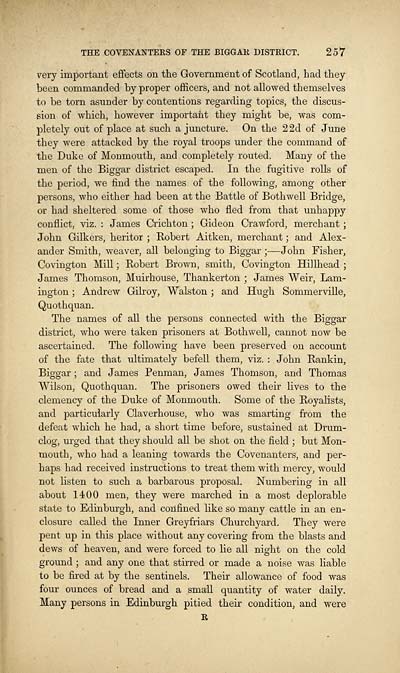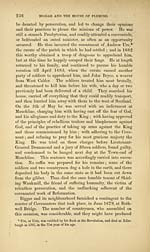Biggar and the House of Fleming
(285) Page 267
Download files
Complete book:
Individual page:
Thumbnail gallery: Grid view | List view

THE COVENANTERS OF THE BIGGAR DISTRICT. 257
very important effects on the Government of Scotland, had they
been commanded by proper officers, and not allowed themselves
to be torn asunder by contentions regarding topics, the discus-
sion of which, however important they might be, was com-
pletely out of place at such a juncture. On the 2 2d of June
they were attacked by the royal troops under the command of
the Duke of Monmouth, and completely routed. Many of the
men of the Biggar district escaped. In the fugitive rolls of
the period, we find the names of the following, among other
persons, who either had been at the Battle of Bothwell Bridge,
or had sheltered some of those who fled from that unhappy
conflict, viz. : James Crichton ; Gideon Crawford, merchant ;
John Gilkers, heritor ; Robert Aitken, merchant ; and Alex-
ander Smith, weaver, all belonging to Biggar ; — John Fisher,
Covington Mill ; Robert Brown, smith, Covington Hillhead ;
James Thomson, Muirhouse, Thankerton ; James Weir, Lam-
ington ; Andrew Gilroy, Walston ; and Hugh Sommerville,
Quothquan.
The names of all the persons connected with the Biggar
district, who were taken prisoners at Bothwell, cannot now be
ascertained. The following have been preserved on account
of the fate that ultimately befell them, viz. : John Rankin,
Biggar ; and James Penman, James Thomson, and Thomas
Wilson, Quothquan. The prisoners owed their lives to the
clemency of the Duke of Monmouth. Some of the Royalists,
and particularly Claverhouse, who was smarting from the
defeat which he had, a short time before, sustained at Drum-
clog, urged that they should all be shot on the field ; but Mon-
mouth, who had a leaning towards the Covenanters, and per-
haps had received instructions to treat them with mercy, would
not listen to such a barbarous proposal. Numbering in all
about 1400 men, they were marched in a most deplorable
state to Edinburgh, and confined like so many cattle in an en-
closure called the Inner Greyfriars Churchyard. They were
pent up in this place without any covering from the blasts and
dews of heaven, and were forced to lie all night on the cold
ground ; and any one that stirred or made a noise was liable
to be fired at by the sentinels. Their allowance of food was
four ounces of bread and a small quantity of water daily.
Many persons in Edinburgh pitied their condition, and were
R
very important effects on the Government of Scotland, had they
been commanded by proper officers, and not allowed themselves
to be torn asunder by contentions regarding topics, the discus-
sion of which, however important they might be, was com-
pletely out of place at such a juncture. On the 2 2d of June
they were attacked by the royal troops under the command of
the Duke of Monmouth, and completely routed. Many of the
men of the Biggar district escaped. In the fugitive rolls of
the period, we find the names of the following, among other
persons, who either had been at the Battle of Bothwell Bridge,
or had sheltered some of those who fled from that unhappy
conflict, viz. : James Crichton ; Gideon Crawford, merchant ;
John Gilkers, heritor ; Robert Aitken, merchant ; and Alex-
ander Smith, weaver, all belonging to Biggar ; — John Fisher,
Covington Mill ; Robert Brown, smith, Covington Hillhead ;
James Thomson, Muirhouse, Thankerton ; James Weir, Lam-
ington ; Andrew Gilroy, Walston ; and Hugh Sommerville,
Quothquan.
The names of all the persons connected with the Biggar
district, who were taken prisoners at Bothwell, cannot now be
ascertained. The following have been preserved on account
of the fate that ultimately befell them, viz. : John Rankin,
Biggar ; and James Penman, James Thomson, and Thomas
Wilson, Quothquan. The prisoners owed their lives to the
clemency of the Duke of Monmouth. Some of the Royalists,
and particularly Claverhouse, who was smarting from the
defeat which he had, a short time before, sustained at Drum-
clog, urged that they should all be shot on the field ; but Mon-
mouth, who had a leaning towards the Covenanters, and per-
haps had received instructions to treat them with mercy, would
not listen to such a barbarous proposal. Numbering in all
about 1400 men, they were marched in a most deplorable
state to Edinburgh, and confined like so many cattle in an en-
closure called the Inner Greyfriars Churchyard. They were
pent up in this place without any covering from the blasts and
dews of heaven, and were forced to lie all night on the cold
ground ; and any one that stirred or made a noise was liable
to be fired at by the sentinels. Their allowance of food was
four ounces of bread and a small quantity of water daily.
Many persons in Edinburgh pitied their condition, and were
R
Set display mode to:
![]() Universal Viewer |
Universal Viewer | ![]() Mirador |
Large image | Transcription
Mirador |
Large image | Transcription
Images and transcriptions on this page, including medium image downloads, may be used under the Creative Commons Attribution 4.0 International Licence unless otherwise stated. ![]()
| Histories of Scottish families > Biggar and the House of Fleming > (285) Page 267 |
|---|
| Permanent URL | https://digital.nls.uk/94842702 |
|---|
| Description | A selection of almost 400 printed items relating to the history of Scottish families, mostly dating from the 19th and early 20th centuries. Includes memoirs, genealogies and clan histories, with a few produced by emigrant families. The earliest family history goes back to AD 916. |
|---|

